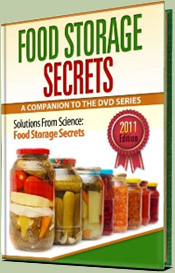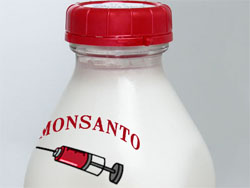With the current controversy surrounding the government crackdown on wholesome, organic, and locally produced milk, it is important to understand the products we are being pushed toward, as well as those we are being pushed away from. While the benefits of organic and raw milk is largely undeniable when compared to the industrially produced substitute, the dangers of the latter are not discussed quite as frequently. Of these dangers, rBGH is a central figure.
Recombinant Bovine Growth Hormone (also known as Recombinant Bovine Somatotropin) is a genetically engineered hormone that is injected into cows for the purpose of increasing milk production.[1] It is derived from bovine somatotropin (bST) which is a hormone that is produced naturally in the cattle by the pituitary gland. This hormone is very important for growth and development, as well as other functions of the animal’s body.
Sometime in the 1930s it was discovered that injecting cattle with bST increased milk production. However, because bST is produced in the animal itself, the only source available was in the pituitary glands of the slaughtered cattle. Genetic engineering thus came into play.
//]]>
This Genetically Modified Organism (GMO) is then injected into the cattle where it replicates causing an increase in milk production.[2] This concept of genetic combination is the foundation for the name “Recombinant” Growth Hormone or Bovine Somatotropin.
As with any GM food, there are very serious health problems associated with the use of rBGH that affect both humans and the animals that are injected with it. Cows who receive the hormone, in addition to the deplorable conditions in which they already find themselves[3], often develop a condition called mastitis, an extremely painful inflammation of the mammary glands.
Of the two forms of mastitis (infectious and non-infectious) non-infectious mastitis accounts for only 1% of the cases in existence and is mainly a result of some kind of injury. The other 99% are a result of infections largely due to bacteria produced by the animals’ living conditions and the rBGH they receive.
There are subsequently four categories of mastitis: peracute, acute, subacute, and subclinical. Of the four, subclinical is the most difficult to diagnose due to the lack of visible physical symptoms.[4] For the most part, it is detected by somatic cell counts.[5]
However, the three other forms of mastitis do render physical symptoms with the peracute form the most pronounced. In this instance the cow’s bag become swollen, red, hot, and/or sensitive to the touch. This is extremely painful to the affected animal since she is being continuously milked by automatic machines and dragging her bag across the floor as she moves in what little space there is. The animal may also suffer from a fever, depression, shivering, rapid weight loss, lack of appetite and even death.

Symptoms may be slightly less obvious or pronounced in the other forms of mastitis, yet they are all part of the same condition which is becoming more and more prevalent not just in dairy cows but in beef herds as well.[6] Due to lack of appetite and reduced nutrition as a result of constant milking (in the case of dairy cows)[7] the amount of milk produced from the animals affected in this way becomes significantly smaller. Likewise, beef herds injected with the chemical tend to be 7% to 12.5% smaller in terms of weight.
Ironically, a hormone injected into animals to make them more productive for dairy and beef often causes a condition which reduces their output in both categories.[8] Even in animals who manage to avoid chronic cases of infection, the milk yield as a result of rBGH only increases by 11.3% to 15.6%.[9]
Yet the increased rate of mastitis is not the only injury to the animals as a result of rBGH. The Canadian Veterinary Medical Association Expert Panel conducted a review of the use of rBGH in dairy cows and reported that incidents of lameness increased by as much as 50% in animals treated with the hormone. The report also noted that sterility (or non-pregnancy) as well as culling was significantly increased as well. Twinning, placenta retention, and abortion/fetal loss were also considered and acknowledged as potential side effects of hormone treatment. [10]
Yet the damage caused by rBGH does not stop with animals injected with it. The repercussions of adding rBGH to dairy cows extend all the way up the food chain to the humans that consume the milk they produce. More will be said about the effects of rBGH on humans in future articles. However, the effects produced in the animals and the cruelty issue alone should be enough to warrant a boycott of milk produced using rBGH.
Sources:
[10] “Report of the Canadian Veterinary Medical Association Expert Panel on rBST,” Health Canada. November, 1998. http://www.hc-sc.gc.ca/dhp-mps/vet/issues-enjeux/rbst-stbr/rep_cvma-rap_acdv_tc-tm-eng.php
Brandon Turbeville is an author out of Mullins, South Carolina. He has a Bachelor’s Degree from Francis Marion University where he earned the Pee Dee Electric Scholar’s Award as an undergraduate. He has had numerous articles published dealing with a wide variety of subjects including health, economics, and civil liberties. He also the author of Codex Alimentarius – The End of Health Freedom and 7 Real Conspiracies.
//



Be the first to comment on "rBGH Milk Production: Animal Cruelty, Genetically Modified Hormones and E. Coli"